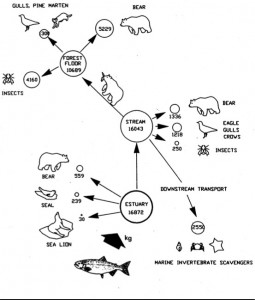
News/Reports
Friends Support for Research
Here are a few examples of how the Friends of Ecological Reserves has provided research grants to support biological and ecological research projects related to ecological reserves in British Columbia. Some of the projects that have or are being supported are profiled below.
What Lies Below at Baeria Rocks Ecological Reserve
2016 : The Friends of Ecological Reserves provided funding to the students of the Diving Class at Bamfield Marine Station for underwater baseline studies at Baeria Rocks ER#24
FER Researchers Protect BCs Biodiversity
Spring 2002
- Do birds need fish? Katie Christie is exploring this question in her studies of the effect of spawning pacific salmon on songbird populations. Salmon spawning is known to affect the terrestrial and aquatic diversity of BC’s forests by providing an annual input of nutrients. Katie intends to determine if this effect is transferred through vegetation and insects to influence bird populations. She is a graduate student at the University of Victoria, working under the supervision of Dr. Tom Reimchen, in watersheds near Bella Coola and Clayoquot Sound
- Salmon, bears and nitrogen in coastal ecosystems: Dr. Tom Reimchen continues his studies on the interaction of salmon and bears in coastal forests. Tom has found that the presence of salmon in streams results in an increase in insect abundance adjacent to the stream. His research shows the extent of ecosystem level changes that occur when salmon are lost from the habitat. “Heavy nitrogen” an isotope of nitrogen is used to track the cycling of nutrients derived from salmon through the food chain. Studies have been done in the Megin River ER (#105)in Clayoquot Sound and in the Khutzamateen grizzly bear sanctuary on the north coast. His work has been celebrated in documentaries and published in other media.
- Support for Research by Tom Reimchen from the Friends of Ecological Reserves.
- The kelp connection: sea otters and sea urchins: Dr. Jane Watson, from Malispina College is studying sea otter and sea urchin dynamics in Checleset Bay ER (#109). Her long-term studies have discovered that sea urchins eat kelp, which provides habitat for fish and sea otters eat sea urchins, controlling their numbers. As a result of the re-introduction of sea otters, the kelp forests are recovering and this should help maintain fish populations. Jane is doing further work to investigate the influence of ocean water temperature on the kelp forests.
- More mushrooms! Mycological studies by Pam Janszen in Saturna Island ER (#15) have identified 365 species of fungi. Pam plans to investigate the relationships between types of fungi and soil, moisture and vegetation. Some of the fungi she has identified were previously unknown in North America and some may be new species.
Winter 2001
- Vivid dancers’ homes in danger: The tepid hotsprings of the Kootenays may not be warm enough to make it worthwhile to shed your clothes, but Sue Salter has discovered that these sites are perfect habitat for red-listed dragonflies. The vivid dancer (Argia vivida) nymph lives in the warm springs at Wildhorse Creek near Top of the World Provincial Park and at Little Wilson Lake near Nakusp. Neither area has any form of protection from human interference.
- Blues, marbles, skippers and checkerspots declining: James Miskelly, a graduate student at the University of Victoria, is working to preserve the Garry oak ecosystem habitat for red- and blue-listed butterflies. The Garry oak ecosystem is home to the Island Blue (Plebejus saepiolus insulanus), Island Marble (Euchloe ausonides), Dun Skipper (Euphyes vestris) and Edith’s Checkerspot (Euphydryas editha taylori). Some of these species have been lost already and the status of others is uncertain. James is locating existing populations and determining the exact features of the habitat. With this information a plan to preserve key habitat can be developed through stewardship programs involving local communities.
Autumn 2000
- Sunflower fields forever: One of the rites of spring is the appearance of fields of yellow sunflowers in the sagebrush country. In the Skwaha Lake ER (#88), Kim Chambers is researching the ecology and use of Balsamorhiza sagitatta (arrow-leaved balsamroot) used by Xaxl’ep First Nation. She is helping to synthesize the ethnobotanical knowledge about the plant and investigate conservation options, including cultivation for her Master’s degree at the University of Victoria, under the supervision of Dr. Nancy Turner.
Autumn 1999
- Moonworts discovered on Texada Island: Harvey Janszen and others spent time searching Texada Island for rare members of the Ophiolossacea or grape-fern family. They found one species of Opioglosssum and 6 species of Botrychium. Other rare vascular plants and fungi were also noted. Information has been provided to the Conservation Data Center (CDC). Harvey is the Saturna Island E.R (#15) warden and does contract work for CDC.
Please contact us at ecoreserves [replace this with the @sign] hotmail.com for more information on these projects.



